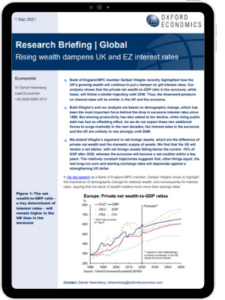Global | Rising wealth dampens UK and EZ interest rates

Bank of England MPC member Gertjan Vlieghe recently highlighted how the UK’s growing wealth will continue to put a damper on gilt interest rates. Our analysis shows that the private net wealth-to-GDP ratio in the eurozone, while lower, will follow a similar trajectory until 2050. Thus, the downward pressure on interest rates will be similar in the UK and the eurozone.
What you will learn:
- Both Vlieghe’s and our analysis are based on demographic change, which has been the most important force behind the drop in eurozone interest rates since 1980.
- We extend Vlieghe’s argument to net foreign assets, which are the difference of private net wealth and the domestic supply of assets.
- We find that the UK will remain a net debtor, with net foreign assets falling below the current -15% of GDP after 2030, whereas the eurozone will become a net creditor within a few years.
- The relatively constant trajectories suggests that, other things equal, the real long-run euro and sterling exchange rates will depreciate against a strengthening US dollar.
Tags:
Related Services

Post
UK: Supply constraints are probably less prominent in the south
The extent to which UK employers can respond to likely 2024 interest rate cuts with increased output, rather than rises in prices and wages, will partly reflect the extent of spare capacity. This will inevitably vary by region. Evidence on this is imperfect, but in terms of capital assets (including intangibles) and labour availability, southern regions appear to be in a stronger position than those in the UK's traditional industrial heartland.
Find Out More
Post
Global Private equity real estate fund maturities spur asset sales
We expect the significant increases in fund maturities, spurred by capital raised over the past decade, to exert upward pressure on the rate of asset disposals as the funds approach the end of their lifecycles.
Find Out More